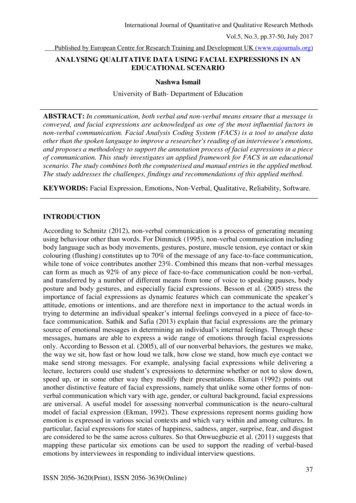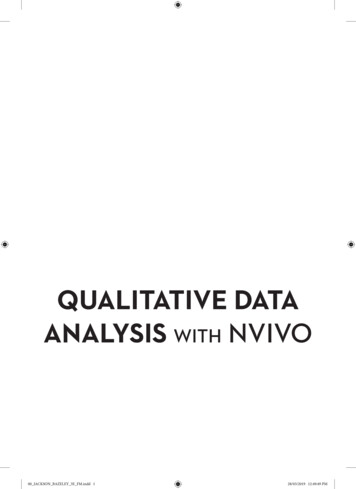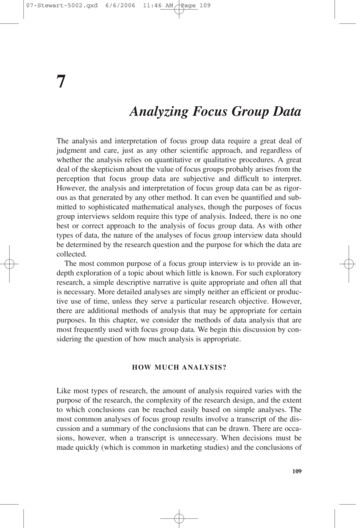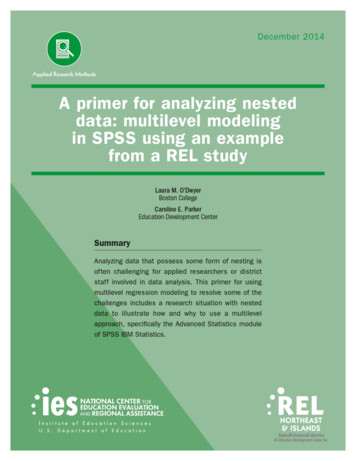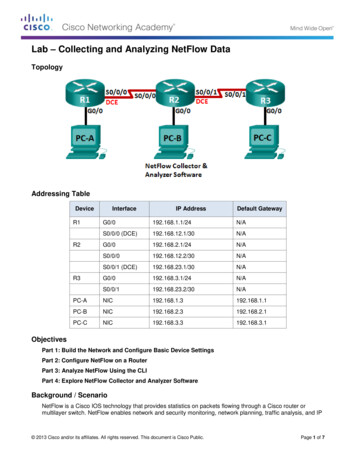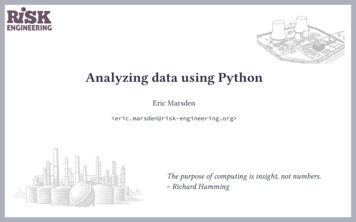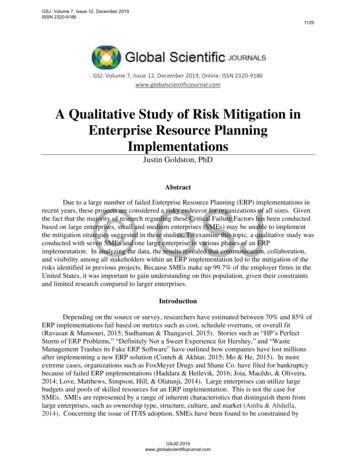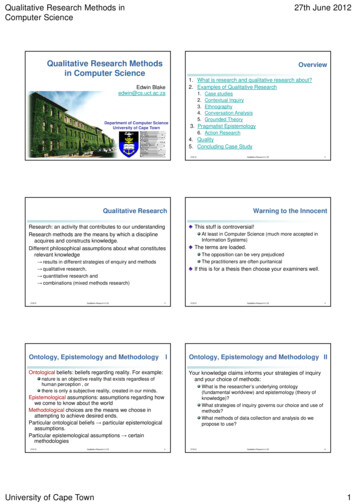
Transcription
Analyzing Qualitative Data:With or without softwareSharlene Hesse-Biber, Ph.D.Department of SociologyBoston CollegeChestnut Hill, MA 02467hesse@bc.edu4/19/101
Role of the ResearcherYOU are a data collection instrument You take notes and decide what topicsto record How much do you set the agenda What questions do you ask or not ask? What do you deem important?
Role of the Researcher You are driving the analysis: What are your implicit/explicit theories? What is your favored analysis method(s)?
Role of the Researcher You make decisions before analysisbased on your: Epistemological perspective Approach to the problem Particular research questions
How should I analyze my qualitativedata? Depends on: What research questions drive your study. Research Question is linked to methodschosen and type of analysis rationale youapply.
Role of Transcription in analysisof your data Builds theoretical sensitivity (Strauss & Corbin,1990)Brings the researcher closer to the data Provides a unique opportunity to critiqueand improve on the interview process Copyrighted Hesse-BiberQualitative Analysis Consulting
What is Transcribed? Written texts: Field notes Supporting documents Audio and/or Visual Data Recordings of interviews, focus groups,consultation Photos VideosCopyrighted Hesse-BiberQualitative Analysis Consulting
Researcher PositionalityThe researcher’s viewpoint is part oftranscription How does your set of social, economic,personal, and other characteristicsimpact the way you represent yourdata? Copyrighted Hesse-BiberQualitative Analysis Consulting
Issues of RepresentationWhose transcription are you creating? Address issues of authority andrepresentation.
Transcription and data analysisreflection:Recognize ways that data areinterpreted and represented. How do you decide what to transcribe(everything or only particular aspects)? Copyrighted Hesse-BiberQualitative Analysis Consulting
Data Analysis: The goal is toanalytically reduce your data by:Producing summaries, abstracts,coding, and memos Finding ways to your displaydata( matrices, frequency counts, etc.) Draw conclusions and test their validity Remember: Analysis is an iterative andongoing process
Memo-ing: A critical link between yourinterview data and creation of codesand categories Memo about: Codes, categories, and their relationships Initial thoughts on data analysisMemos are ways of Summarizing where you are atduring your analysis and potential interpretations youmay have about your data.Analysis is saying: What does the data say.Interpretation is saying: What does it mean?
Data Analysis asData ReductionManagement goal is to make large amountof data manageable Analysis goals: Search for commonalities, which lead to categories(know as codes or themes) Search for contrasts/comparisons There is Physical reduction of data (putting nameson excerpts as if you are creating labels in a filingcabinet with no analytical bite Conceptual reduction of data: Thinking throughmeaning by coding—memo-ing—re-coding formeaning
Data Reduction But how do I dothis?Know your data: listen, read, and thinkabout it Know your biases and standpoint Focus on the data – one way is to take agrounded approach. But rememberthere are multiple analytical styles (i.e.narrative analysis, content analysis, etc.Go back to your research question todetermine analytical rationale
Coding Styles: Deductive Codingof your data Starts with pre-set themes/codes/categoriesThemes suggested by research literature,advisor, etc.Provides direction in your analysisYet: Do you want to start out with a set ofthemes a priori? Why? Go back to yourresearch question. If you are exploring newterritory it may not be best to start out lookingfor “a something.”
Inductive coding style: Iterativeanalysis (often referred to as aGrounded Analysis.Your analysis– codes come directly fromreading/thinking about data Part of iterative process that is often alike an upward spiral in which you go upand down the twists and turns almostlike a dance-- a tango that has nostraight lines.
Inductive (Grounded) AnalysisIterative process After initial coding, go back to changeand break down codes
Developing Grounded CodesCode: symbol applied to a section of textin order to easily categorize it Related to research questions, themes,concepts Used for retrieval and organization Finish coding when saturation isreached
Developing Grounded ThemesDuring and after coding, look forconnections between codes Begin with descriptive themes Look for subcategories, relationships,cause-effect Develop a matrix of codes and themes
Differentiating Types of GroundedCodes:Tag Code Category Themes
Using Software to AnalyzeQualitative DataTranscription Software:Using HyperTranscribe Computer-AssistedSoftware: UsingHyperRESEARCH
Advantages of Computer-AssistedQualitative Data Analysis(CAQDAS).Enhances ability to play with the data Assists in development of organizingsystem Theory building and construction Exploring different possibilities of dataanalysis and interpretation Copyrighted Hesse-BiberQualitative Analysis Consulting
Advantages of CAQDASCreate and share large data sets Access facilitates group projects Allows for secondary analysis ofqualitative data sets Copyrighted Hesse-BiberQualitative Analysis Consulting
Advantages of CAQDASFacilitates exploration of epistemologicalissues Works as a pedagogical tool forqualitative research methods Copyrighted Hesse-BiberQualitative Analysis Consulting
Transcription as Analysis withComputer SoftwareTransition marker: using time stamps tohighlight transitions, etc. Mark text in color Insert memos using representative fonts Copyrighted Hesse-BiberQualitative Analysis Consulting
Benefits of TranscriptionTechnologiesDecrease time and money spent ontranscription More easily used by junior teammembers Simplified technologies allowresearchers to do own transcription Copyrighted Hesse-BiberQualitative Analysis Consulting
HyperTRANSCIBETM Allows you to watch or listen to video oraudio file during transcription and takememos on the flySingle interface for media and transcriptionAllows you to time-stamp your transcriptionfor easy retrieval and analysis on the flyHands never have to leave the keyboardSupports common video formats such as AVI,QuickTime, MPEG-2, MPEG-4Copyrighted Hesse-BiberQualitative Analysis Consulting
HyperTRANSCIBETM
HyperTRANSCIBETMSimple control over timingoptionsCopyrighted Hesse-BiberQualitative Analysis Consulting
HyperTRANSCIBETM Add textshortcuts to speed up thetranscription processCopyrighted Hesse-BiberQualitative Analysis Consulting
HyperTRANSCIBETM Download a free demo atwww.researchware.comCopyrighted Hesse-BiberQualitative Analysis Consulting
HyperRESEARCH 2.8CAQDAS for Win and Macintosh Used for a variety of fields and analyticalstyles Facilitates group work Allows code and retrieval of data: Boolean/proximity searches Auto-coding and viewing codes in contextCopyrighted Hesse-BiberQualitative Analysis Consulting
HyperRESEARCH 2.8Uses AI to create complex codecategories Summary memos on data documents Hyperlinking Theory building Hypothesis testing Cognitive mapping Code listsCopyrighted Hesse-BiberQualitative Analysis Consulting
HyperRESEARCH 2.8 Links qualitative and quantitative Export matrices Import quantitative data Detailed summary reportsCopyrighted Hesse-BiberQualitative Analysis Consulting
Study StructureStudyCase 01Case 02Text Source 01Image Source 01Audio/Video Source 01Text Source 02Image Source 02Audio/Video Source 02Text Source nImage Source nAudio/Video Source nCopyrighted Hesse-BiberQualitative Analysis ConsultingCase n
Case CardCopyrighted Hesse-BiberQualitative Analysis Consulting
View codes in contextCopyrighted Hesse-BiberQualitative Analysis Consulting
Code List EditorCopyrighted Hesse-BiberQualitative Analysis Consulting
Memoing in MasterCode ListDefine code categories on the fly Copyrighted Hesse-BiberQualitative Analysis Consulting
Selecting Cases or Codes Select allSelect by choosingfrom a listSelect using aBoolean expression(note:All subsequent browsingor analysis is done usingthe SELECTED subset ofcases and codes)Copyrighted Hesse-BiberQualitative Analysis Consulting
Selecting Cases or CodesOverlaps Includes Equals Copyrighted Hesse-BiberQualitative Analysis Consulting
CodingHyperRESEARCH addscodes on the fly.Or use the Master Code ListEditor toadd codes without attachingthem to text or mediasegmentsA code definition may beaddedfor each master code. 30,000characters/codeCopyrighted Hesse-BiberQualitative Analysis Consulting
Code MapCopyrighted Hesse-BiberQualitative Analysis Consulting
Coding ImagesImage FROM: http://ed.stanford.edu/IT/training/workshop handouts/HyperRESEARCH-handout.pdf.Copyrighted Hesse-BiberQualitative Analysis Consulting
Coding Video and AudioImage FROM: http://ed.stanford.edu/IT/training/workshop handouts/HyperRESEARCHhandout.pdf.Copyrighted Hesse-BiberQualitative Analysis Consulting
Running ReportsCopyrighted Hesse-BiberQualitative Analysis Consulting
Auto Code: Choose SourcesCopyrighted Hesse-BiberQualitative Analysis Consulting
Auto Code: Choose PhrasesCopyrighted Hesse-BiberQualitative Analysis Consulting
ReportingBased on cases andcodes Display, print, orexport A report is based on the set of casesAND codes you have selected.The checkboxes specify whichelements are included a report.Reports may be displayed, printed orexportedCopyrighted Hesse-BiberQualitative Analysis Consulting
Hypothesis Tester & TheoryGeneratorCopyrighted Hesse-BiberQualitative Analysis Consulting
Integrating Qualitative Analysiswith Software: A Step by StepApproach with some examplesof the “how to’s”Copyrighted Hesse-BiberQualitative Analysis Consulting
Exploration Phase Steps in Analysis Computer Function Read text and thinkof codes (alsoreferred to as‘indexing’ or‘tagging’ Assign codes tosegments Assign codes Attaches codes totext segments;automatic coding orwords and phrasesCopyrighted Hesse-BiberQualitative Analysis Consulting
Add Codes to TextCopyrighted Hesse-BiberQualitative Analysis Consulting
Exploration Phase Steps in Analysis Computer Function Clarify codes ifnecessary Writing memosabout codes andnew directions inresearch; link codesto the researchquestions Assigns codes,overview of codes,create theorymemos, attachmemos to text/codes Memoing,theorymemos, formulatenew questions /hypothesesCopyrighted Hesse-BiberQualitative Analysis Consulting
Line by Line CodingText:Code:I always wanted to be the thinnest, the prettiestThinnest, PrettiestI wanted to look like the girls in the magazinesI’m going to have so boyfriends and boys are goingGoing to be so in love with me, I won’t have toeconomicresourceswork and I’ll be taken care of me for therest of my lifesecurityStandardsPos. body imageProvidesThin RationaleThinness asMediaCopyrighted Hesse-BiberQualitative Analysis Consulting
Evaluation of codesInitial codes in Eating Disorders Study were changed as follows:FROM:TO:Clothing made for thin people clothing that fitsWeight lower priority concerned with weight appearanceMinimal diet .control over body and eatingMagazines .media creates standardsDating and appearance .men control women by appearanceWill always want to be thin .values thinnessThin rationales:Thin as a means of SecurityThin and HealthyThin as Part of IdentityThin /Beauty is EmpoweringCopyrighted Hesse-BiberQualitative Analysis Consulting
Using diagrams Thin as a means of Security Thin and Health Thin as Part of Identity Thin /Beauty is EmpoweringThinRationalesCopyrighted Hesse-BiberQualitative Analysis Consulting
Meta Coding: Going from LargerThemes to Detailed AnalysisMeta Code: Pressure to be thin or thick Sub codes: media source of thin pressureno pressure to be thinpeer pressure to be thinpressure to be thinpressure to gain weightresists pressure to be thinteased about skinniness
HierarchicalCodingAttitudes towards yright, Hesse-Biber/Associatesin Qualitative ConsultingNeutralDon’t Care
Memoing Codes in Context
Memoing in Context: An Example Code: Being thickThroughout all interviews it was clear thatbeing thin is not only not a valued social norm,but is also often considered a negativeattribute associated with starvation and illhealth ( several kids associated being thin withbeing bony). Conversely, being heavy or ‘thick’was associated with health and sexuality ( oneboy said he liked it when ‘things gjggle’). Itwas commonly acknowledged that guys like a“big butt” and a “big chest.”copyright, Hesse-Biber/Associatesin Qualitative Consulting
Data Reduction Phase Steps in Analysis Computer Function Linking textsegments that havethe same meaning Retrieval of textsegments by codesor combinations ofcodescopyright, Hesse-Biber/Associatesin Qualitative Consulting
Data Reduction Phase Steps in Analysis Perform open andaxial coding Formulate initial codecategories Create analyticalcodes and checkwith material May want to subcategorize orintegrate categories Computer Function Perform coding andretrieval of codesegments Create a hierarchicalcoding structure Create and analyzememos Change/adjustsegments and codes Create methodologicalmemoscopyright, Hesse-Biber/Associatesin Qualitative Consulting
Data Reduction: An ExampleCode: Attitudes towards appearance Subcodes: Importance of looks in the estimation of self/others Worries about appearance Important aspects of appearance Social support or pressures re: appearancecopyright, Hesse-Biber/Associatesin Qualitative Consulting
Metacodes: An ExampleC
What questions do you ask or not ask? . interview data and creation of codes and categories Memo about: Codes, categories, and their relationships Initial thoughts on data analysis Memos are ways of Summarizing where you are at during your analysis and potential interpretations you may have about your data. Analysis is saying: What does the data say. Interpretation is saying: What does it .
